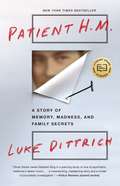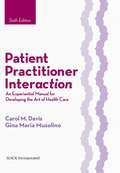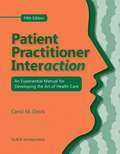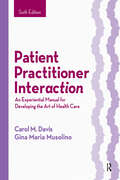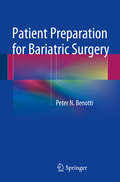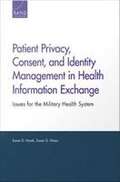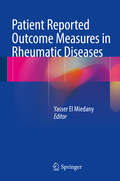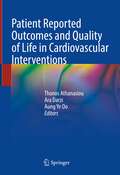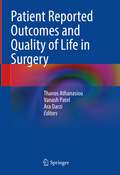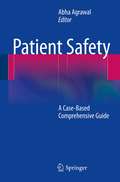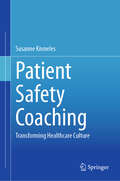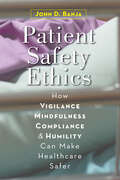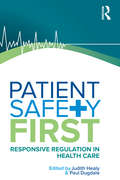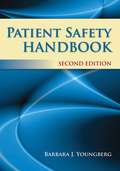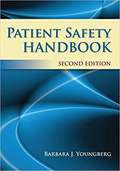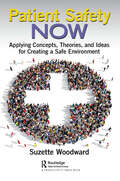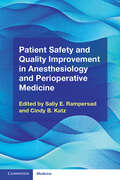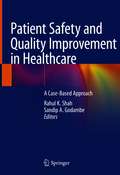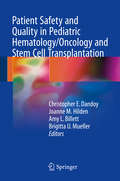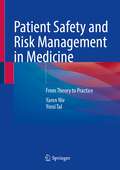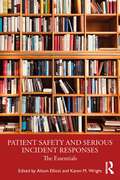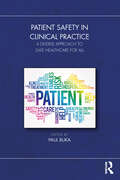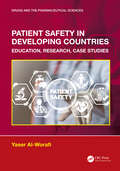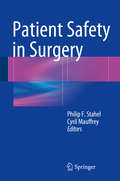- Table View
- List View
Patient H.M.: A Story of Memory, Madness, and Family Secrets
by Luke Dittrich"Oliver Sacks meets Stephen King"* in this propulsive, haunting journey into the life of the most studied human research subject of all time, the amnesic known as Patient H.M., a man who forever altered our understanding of how memory works--and whose treatment raises deeply unsettling questions about the human cost of scientific progress. For readers of The Immortal Life of Henrietta Lacks comes a story that has much to teach us about our relentless pursuit of knowledge. *Kirkus Reviews (starred review) In 1953, a twenty-seven-year-old factory worker named Henry Molaison--who suffered from severe epilepsy--received a radical new version of the then-common lobotomy, targeting the most mysterious structures in the brain. The operation failed to eliminate Henry's seizures, but it did have an unintended effect: Henry was left profoundly amnesic, unable to create long-term memories. Over the next sixty years, Patient H.M., as Henry was known, became the most studied individual in the history of neuroscience, a human guinea pig who would teach us much of what we know about memory today. Patient H.M. is, at times, a deeply personal journey. Dittrich's grandfather was the brilliant, morally complex surgeon who operated on Molaison--and thousands of other patients. The author's investigation into the dark roots of modern memory science ultimately forces him to confront unsettling secrets in his own family history, and to reveal the tragedy that fueled his grandfather's relentless experimentation--experimentation that would revolutionize our understanding of ourselves. Dittrich uses the case of Patient H.M. as a starting point for a kaleidoscopic journey, one that moves from the first recorded brain surgeries in ancient Egypt to the cutting-edge laboratories of MIT. He takes readers inside the old asylums and operating theaters where psychosurgeons, as they called themselves, conducted their human experiments, and behind the scenes of a bitter custody battle over the ownership of the most important brain in the world. Patient H.M. combines the best of biography, memoir, and science journalism to create a haunting, endlessly fascinating story, one that reveals the wondrous and devastating things that can happen when hubris, ambition, and human imperfection collide.Praise for Patient H.M."An exciting, artful blend of family and medical history."--The New York Times"Patient H.M. tells one of the most fascinating and disturbing stories in the annals of medicine, weaving in ethics, philosophy, a personal saga, the history of neurosurgery, the mysteries of human memory, and an exploration of human ego."--Sheri Fink, M.D., Pulitzer Prize winner and author of Five Days at Memorial "Dittrich explores the limits of science and the mind. In the process, he rescues an iconic life from oblivion. Dittrich is well aware that while we are the sum of what we may remember, we're also at the mercy of what we can forget. This is classic reporting and myth-making at the same time."--Colum McCann, author of Let the Great World Spin "This book succeeds on every level: as a fresh look at the most famous patient in medical history, as an exposé of our dark history of psychiatry and neurosurgery, and, most powerfully, as a deeply personal investigation into the author's past. And yet it's still a page-turner that reads like a thriller."--Susannah Cahalan, author of Brain on FireFrom the Hardcover edition.
Patient Practitioner Interaction: An Experiential Manual For Developing The Art Of Health Care
by Carol M. Davis Gina Maria MusolinoFor over 20 years, Patient Practitioner Interaction: An Experiential Manual for Developing the Art of Health Care has been the cornerstone textbook for health care professionals to learn and develop effective interpersonal professional behavior. Building on the foundational knowledge of past editions, the updated Sixth Edition continues to teach health care professionals how to develop self-awareness and communication skills critical to providing ethical, compassionate, and professional treatment and care for and with their patients. Drs. Carol M. Davis and Gina Maria Musolino designed the textbook to assist both faculty and students through instructional and learning objectives emphasizing the importance of self-awareness in patient interaction. The Sixth Edition guides faculty in teaching the essential component required of all health care professionals: the ability to know oneself and one's patterns of response in highly contentious situations. Through the featured learning activities and chapters on self-awareness and self-assessment, students will be able to better understand, change, and evaluate their learned patterns, values, and readiness for mature patient interactions for both typical and challenging patient care situations. The learned skills of self-awareness and effective interpersonal communication allow clinicians, faculty, and students to provide compassionate and therapeutic treatment and care for the good of the patients and their families. Developing health care providers are also guided in new focus areas in health care leadership and advocacy through interactive exercises. Features and benefits of the Sixth Edition: Four chapters on self-awareness to guide students in evaluating their values and readiness for mature interaction with patients under stressful situations, as well as their ability and capability for self-assessment and peer-assessment Interactive and online learning activities of real-life clinical situations and vignettes with tools provided to use in the classroom to make learning active and engaging. New content areas addressing leadership and advocacy with professional and community organizations; and self and peer assessment for fostering reflective professional development. An accompanying Instructor's Manual to help faculty learn how to convey the material in effective ways Instructors in educational settings can visit www. efacultylounge. com for additional material to be used for teaching in the classroom. Patient Practitioner Interaction: An Experiential Manual for Developing the Art of Health Care, Sixth Edition will continue to be the go-to resource for students, faculty, and clinicians in allied health professions for effective patient interaction.
Patient Practitioner Interaction: An Experiential Manual for Developing the Art of Health Care
by Carol M. DavisOver 20 years ago, Dr. Carol M. Davis created the path for teaching health care professionals how to develop self-awareness and communication skills critical to providing ethical, compassionate, and professional treatment and care to their patients. That path is Patient Practitioner Interaction: An Experiential Manual for Developing the Art of Health Care, now in its Fifth Edition. While the ways of communication have evolved over the last 23 years, the face-to-face role of the practitioner and patient has not. With technology having a large presence in health care, the personal interaction and comfort provided by the health care professional serves an even more important purpose in facilitating healing with therapeutic presence. Patient Practitioner Interaction, Fifth Edition begins with chapters that assist students in self-awareness and understanding of their own history in developing their values and communication skills. This then guides the student into learning how to differentiate personal values from professional values. In the remaining chapters, Dr. Carol M. Davis and her contributors take Patient Practitioner Interaction, Fifth Edition into the heart of the text: teaching actual skill development in communicating with patients, as well as skills in diagnosis, prognosis, and treatment. The updated exercises at the end of each chapter encourage an essential element in the inculcation of these fundamental skills -- reflection and personalization of the material to ones own story. New in the Fifth Edition: * A new chapter on communicating about spirituality that teaches health care professionals to better assess the needs of patients and families dealing with hope, faith, and despair * New material on communicating in the information age * A reorganization of the chapters, contemporary terminology, and references * New and updated exercises at the end of each chapter in the book.
Patient Practitioner Interaction: An Experiential Manual for Developing the Art of Health Care
by Carol M. Davis Gina Maria MusolinoFor over 20 years, Patient Practitioner Interaction: An Experiential Manual for Developing the Art of Health Care has been the cornerstone textbook for health care professionals to learn and develop effective interpersonal professional behavior. Building on the foundational knowledge of past editions, the updated Sixth Edition continues to teach health care professionals how to develop self-awareness and communication skills critical to providing ethical, compassionate, and professional treatment and care for and with their patients. Drs. Carol M. Davis and Gina Maria Musolino designed the textbook to assist both faculty and students through instructional and learning objectives emphasizing the importance of self-awareness in patient interaction. The Sixth Edition guides faculty in teaching the essential component required of all health care professionals: the ability to know oneself and one’s patterns of response in highly contentious situations. Through the featured learning activities and chapters on self-awareness and self-assessment, students will be able to better understand, change, and evaluate their learned patterns, values, and readiness for mature patient interactions for both typical and challenging patient care situations. The learned skills of self-awareness and effective interpersonal communication allow clinicians, faculty, and students to provide compassionate and therapeutic treatment and care for the good of the patients and their families. Developing health care providers are also guided in new focus areas in health care leadership and advocacy through interactive exercises. Features and benefits of the Sixth Edition: Four chapters on self-awareness to guide students in evaluating their values and readiness for mature interaction with patients under stressful situations, as well as their ability and capability for self-assessment and peer-assessment Interactive and online learning activities of real-life clinical situations and vignettes with tools provided to use in the classroom to make learning active and engaging. New content areas addressing leadership and advocacy with professional and community organizations; and self and peer assessment for fostering reflective professional development. An accompanying Instructor’s Manual to help faculty learn how to convey the material in effective ways Included with the text are online supplemental materials for faculty use in the classroom. Patient Practitioner Interaction: An Experiential Manual for Developing the Art of Health Care, Sixth Edition will continue to be the go-to resource for students, faculty, and clinicians in allied health professions for effective patient interaction.
Patient Preparation for Bariatric Surgery
by Peter N. BenottiPatient Preparation for Bariatric Surgery provides a comprehensive and state of the art review of all aspects of the patient preparation process, The text reviews current literature and controversies involving sources of referrals and the difficulties encountered by primary care physicians in managing patients with extreme obesity. Strategies for addressing this problem and integrating primary care physicians in comprehensive obesity programs are presented. The text also reviews current indications for surgery and the current patient access limitations that have resulted in the need for revised surgical indications based more on medical need than mere extent of obesity. Written by an authority in the field, Patient Preparation for Bariatric Surgery is a valuable resource for bariatric surgeons, bariatric physicians and all allied health personnel who manage patients with extreme obesity and will assist in the advancement of this area of surgery as well as stimulate new discovery.
Patient Privacy, Consent, and Identity Management in Health Information Exchange
by Susan G. Straus Susan D. HosekThe Military Health System (MHS) and the Veterans Health Administration (VHA) have been among the nation's leaders in health information technology (IT), including the development of health IT systems and electronic health records that summarize patients' care from multiple providers. Health IT interoperability within MHS and across MHS partners, including VHA, is one of ten goals in the current MHS Strategic Plan. As a step toward achieving improved interoperability, the MHS is seeking to develop a research roadmap to better coordinate health IT research efforts, address IT capability gaps, and reduce programmatic risk for its enterprise projects. This report contributes to that effort by identifying gaps in research, policy, and practice involving patient privacy, consent, and identity management that need to be addressed to bring about improved quality and efficiency of care through health information exchange. Major challenges include (1) designing a meaningful patient consent procedure, (2) recording patients' consent preferences and designing procedures to implement restrictions on disclosures of protected health information, and (3) advancing knowledge regarding the best technical approaches to performing patient identity matches and how best to monitor results over time. Using a sociotechnical framework, this report suggests steps for overcoming these challenges and topics for future research. Book jacket.
Patient Reported Outcome Measures in Rheumatic Diseases
by Yasser El MiedanyThis book discusses the role of patient reported outcome measures (PROMs) in the diagnosis and management of rheumatic diseases and their implementation in patient-centered care. It aims to improve the quality and efficiency of patient care in standard practice by outlining the appropriate information-gathering and decision-making processes. The book highlights the evidence and advanced knowledge base of PROMs in rheumatic diseases such as rheumatoid arthritis, systemic lupus erythematosus, juvenile idiopathic arthritis, osteoarthritis, and systemic sclerosis. Featuring reviews of Patient Reported Outcome tools and Physician RheuMetric Measures as well as examples of patient reported outcome questionnaires, "Patient Reported Outcome Measures in Rheumatic Diseases "serves as an excellent introduction and resource for implementation of PROMs in clinical rheumatology practice.
Patient Reported Outcomes and Quality of Life in Cardiovascular Interventions
by Ara Darzi Thanos Athanasiou Aung Ye OoThis book provides a guide to the assessment of patient reported outcomes measures and quality of life in cardiovascular interventions, which have become a fundamental component of decision making in bedside medicine, health policy, health economics, and public health. Cardiac surgery, cardiovascular interventions, vascular interventions, and the core principles of quality of life are all covered. This book is the first book to demonstrate how clinicians and policy makers can easily get access to a single source of quality of life and patient reported outcomes measures evidence to help them make the best informed decisions in the field of cardiovascular interventions. This is a rapidly emerging field and the book would be relevant to doctors, healthcare scientists, allied-health professionals, healthcare managers, medical statisticians, healthcare economists, and consultants working in healthcare.
Patient Reported Outcomes and Quality of Life in Surgery
by Ara Darzi Thanos Athanasiou Vanash PatelThis book provides a guide to the assessment of quality of life and patient reported outcomes measures in general surgery. The rapidly emerging field helps contextualise patients and helps the decision-making process within health economics, bedside medicine, public health, and health policy. All subspecialties of general surgery are covered, as well as the core principles of quality of life.The book aims to demonstrate how clinicians and policymakers can easily get access to a single source of patient reported outcomes measures and quality of life evidence to help them make the best-informed decisions in the field of general surgery.This book is relevant to healthcare managers, doctors, allied health professionals, healthcare scientists, consultants, healthcare economists, and medical statisticians working in healthcare.
Patient Safety
by Abha AgrawalDespite the evolution and growing awareness of patient safety, many medical professionals are not a part of this important conversation Clinicians often believe they are too busy taking care of patients to adopt and implement patient safety initiatives and that acknowledging medical errors is an affront to their skills. Patient Safety provides clinicians with a better understanding of the prevalence, causes and solutions for medical errors; bringing best practice principles to the bedside Written by experts from a variety of backgrounds, each chapter features an analysis of clinical cases based on the Root Cause Analysis (RCA) methodology, along with case-based discussions on various patient safety topics The systems and processes outlined in the book are general and broadly applicable to institutions of all sizes and structures. The core ethic of medical professionals is to "do no harm" Patient Safety is a comprehensive resource for physicians, nurses and students, as well as healthcare leaders and administrators for identifying, solving and preventing medical error.
Patient Safety Coaching: Transforming Healthcare Culture
by Susanne KnowlesThis book argues that patient safety is the cornerstone of high-quality healthcare, and that we need to highlight the positive impact of a Safety-11 approach to risk management to improve the quality of patient services and care. Moreover, the author emphasizes the importance of upskilling leaders with coaching capability within the healthcare facility so that decisions can be made quickly to prevent adverse events. In light of this, this book aims to equip clinical leaders across all levels and in all areas of healthcare organizations with the knowledge and skills to develop a patient safety culture in their team and organization based on evidence-based contemporary research into patient safety practices. The author also proposes strengthening leader capability by outlining how they can create a psychologically safe working environment and adopt a coaching leadership style that promotes staff wellbeing and patient care. This book provides strategies for leaders so they can ensure staff wellbeing at work and a patient-centric approach to patient care. It outlines how clinical leaders can support team members to reduce their stress, better utilize their strengths, practice mindfulness, remain positive, and build resilience in the face of adversity, whilst also fostering a workplace culture of trust, support, and compassion. Lastly, this book aims to provide high-level executives and experienced clinical leaders with contemporary knowledge of governance issues and the best practice methods concerning patient safety as a quality improvement strategy.
Patient Safety Ethics: How Vigilance, Mindfulness, Compliance, and Humility Can Make Healthcare Safer
by John D. BanjaDeveloping best practices and ethical systems to protect and enhance patient safety.Human errors occur all too frequently in medical practice settings. One sobering recent report claimed that medical errors are the third leading cause of death in the United States. Hoping to reverse this disturbing trend but wondering why it is that things usually go well despite errors, John D. Banja's Patient Safety Ethics lays out a model that advocates vigilance, mindfulness, compliance, and humility as core ethical principles of patient safety. Arguing that the safe provision of healthcare is one of the most fundamental moral obligations of clinicians, Banja surveys the research literature on harm-causing medical errors to explore the ethical foundations of patient safety and to reduce the severity and frequency of medical error. Drawing on contemporary scholarship on quality improvement, risk management, and medical decision making, Banja also relies on a novel source of information to illustrate patient safety ethics: medical malpractice suits. Providing professional perspective with insights from prominent patient safety experts, Patient Safety Ethics identifies hazard pitfalls and suggests concrete ways for clinicians and regulators to improve patient safety through an ethically cultivated program of "hazard awareness."
Patient Safety First: Responsive regulation in health care
by Judith Healy Paul DugdaleEach year more people die in health care accidents than in road accidents. Increasingly complex medical treatments and overstretched health systems create more opportunities for things to go wrong, and they do. Patient safety is now a major regulatory issue around the world, and Australia has been at its leading edge. Self-regulation by professional and industry groups is now widely regarded as insufficient, and government is stepping in.In Patient Safety First eading experts survey the governance of clinical care. Framed within a theory of responsive regulation, core regulatory approaches to patient safety are analysed for their effectiveness, including information systems, corporate and public institution governance models, the design of safe systems,the role of medical boards, open disclosure and public inquiries. Patient Safety First includes chapters by Bruce Barraclough, John Braithwaite, Stephen Duckett and Ian Freckleton SC. It is essential reading for all medical and legal professionals working in patient safety as well as readers in public health, health policy and governance.
Patient Safety Handbook
by Barbara J. YoungbergIn the current climate of managed care, tight cost controls, limited resources, and the growing demand for health care services, conditions for medical errors are ripe. Nearly 100,000 people die each year from medical errors and tens of thousands more are injured. This comprehensive handbook on patient safety reflects the goals of many in the health care industry to advance the reliability of healthcare systems worldwide. With contributions from prominent thought leaders in the field, this thoroughly revised, Second Edition of The Patient Safety Handbook looks at all the recent changes in the industry and offers practical guidance on implementing systems and processes to improve outcomes and advance patient safety. The book covers the full spectrum of patient safety and risk reduction— from the fundamentals of the science of safety, through a thorough discussion of operational issues, and the application of the principles of research. Real-life case studies from renowned health care organizations and their leadership help the reader understand the practical application of the strategies presented. Key Features: • Offers contributions from prominent thought leaders in both academia and the profession. • Examines the newest scientific advances in the science of safety. • Includes real-life case studies from renowned health care organizations.
Patient Safety Handbook
by Barbara J. YoungbergIn the current climate of managed care, tight cost controls, limited resources, and the growing demand for health care services, conditions for medical errors are ripe. Nearly 100,000 people die each year from medical errors and tens of thousands more are injured. This comprehensive handbook on patient safety reflects the goals of many in the health care industry to advance the reliability of healthcare systems worldwide. <p><p> With contributions from prominent thought leaders in the field, this thoroughly revised, Second Edition of The Patient Safety Handbook looks at all the recent changes in the industry and offers practical guidance on implementing systems and processes to improve outcomes and advance patient safety. The book covers the full spectrum of patient safety and risk reduction― from the fundamentals of the science of safety, through a thorough discussion of operational issues, and the application of the principles of research. Real-life case studies from renowned health care organizations and their leadership help the reader understand the practical application of the strategies presented.
Patient Safety Now: Applying Concepts, Theories, and Ideas for Creating a Safe Environment
by Suzette WoodwardOver the past decade or so, we have seen a multitude of improvement programmes and projects to improve the safety of patient care in healthcare. However, the full potential of these efforts and especially those that seek to address an entire system has not yet been reached. The current pandemic has made this more evident than ever. We have tended to focus on problems in isolation, one harm at a time, and our efforts have been simplistic and myopic. If we are to save more lives and significantly reduce patient harm, we need to adopt a holistic, systematic approach that extends across cultural, technological, and procedural boundaries. Patient Safety Now is about the fact that it is time to care for everyone impacted by patient safety, how we need to take the time to care for everyone in a meaningful way and how hospitals need to enable staff time to care safely. This book builds on the author’s two previous books on patient safety. Rethinking Patient Safety talked about ways in which we need to rethink patient safety in healthcare and describes what we’ve learned over the last two decades. Implementing Patient Safety talked about what we can do differently and how we can use those lessons learned to improve the way we implement patient safety initiatives and encourage a culture of safety across a healthcare system. Patient Safety Now unites the concepts, theories and ideas of the previous two books with updated material and examples, including what has been learned by patient safety specialists during a pandemic. Patient Safety Now provides the reader with a unique view of patient safety that looks beyond the traditional negative and retrospective approach to one that is proactive and recognizes the impact of conditions, behaviours and cultures that exist in healthcare on everyone. It is written not only for healthcare professionals and patient safety personnel, but for patients and their families who all want the same thing. Too often when things go wrong, relationships quickly become adversarial when in fact this can be avoided by recognizing that, rather than being in separate camps, there are shared needs and goals in relations to patient safety.
Patient Safety and Managing Risk in Nursing (Transforming Nursing Practice)
by Miss Margaret Scott Melanie FisherPatient safety is a predominant feature of quality healthcare and something that every patient has the right to expect. As a nurse, you must consider the safety of the patient as paramount in every aspect of your role; and it is now an increasingly important topic in pre-registration nursing programmes. This book aims to provide you with a greater understanding of how to manage patient safety and risk in your practice. The book focuses on the essentials that you need to know, and therefore provides a clear pathway through what can sometimes seem an overwhelmingly complex mass of rules, procedures and possible options. Key features: · A practical introduction to patient safety and risk management written specifically for nurses and nursing students · Case studies and scenarios help you to apply patient safety and risk management principles to actual practice · Each chapter is mapped to the relevant NMC standards and Essential Skills Clusters so that you can see how you are meeting the professional requirements · Activities throughout help you to think critically and reflect on practice.
Patient Safety and Quality Improvement in Anesthesiology and Perioperative Medicine
by Sally E. Rampersad Cindy B. KatzAn accessible and richly illustrated guidebook to the most important methodologies and frameworks for improving safety and quality, written specifically for clinicians in anaesthesia and perioperative medicine. The book begins with chapters on design and the use of simulation to set the stage for successful quality improvement (QI) efforts before providing an in-depth look at the individual tools, reporting and use of databases. The following chapters then discuss the use of these tools and theories in practical projects. Finally, the book considers the difficult topic of people, communication and behaviour, importantly addressing the human factors that can make or break QI efforts. The book skilfully blends expert knowledge and valuable examples from years of experience and trials from varied providers to demonstrate the successful paths to improve patient outcomes. For clinicians, nurses and trainees in anaesthesia and perioperative medicine seeking tools and strategies to lead and participate in QI projects.
Patient Safety and Quality Improvement in Healthcare: A Case-Based Approach
by Rahul K. Shah Sandip A. GodambeThis text uses a case-based approach to share knowledge and techniques on how to operationalize much of the theoretical underpinnings of hospital quality and safety. Written and edited by leaders in healthcare, education, and engineering, these 22 chapters provide insights as to where the field of improvement and safety science is with regards to the views and aspirations of healthcare advocates and patients. Each chapter also includes vignettes to further solidify the theoretical underpinnings and drive home learning. End of chapter commentary by the editors highlight important concepts and connections between various chapters in the text.Patient Safety and Quality Improvement in Healthcare: A Case-Based Approach presents a novel approach towards hospital safety and quality with the goal to help healthcare providers reach zero harm within their organizations.
Patient Safety and Quality in Pediatric Hematology/Oncology and Stem Cell Transplantation
by Christopher E. Dandoy Joanne M. Hilden Amy L. Billett Brigitta U. MuellerThis volume provides a concise yet comprehensive overview of patient safety issues and quality improvement for the pediatric hematology/oncology/stem cell transplant practice. The book reviews patient safety in complex healthcare delivery systems, delineates the various safety issues affecting pediatric hematology/oncology patients, and discusses quality improvement methods and improvement science that allow the reader to implement and sustain change in their home institution. The text also explores mechanisms to measure quality and safety outcomes, allowing the provider to implement proven processes shown to minimize harm to patients. Written by experts in the field, Patient Safety and Quality in Pediatric Hematology/Oncology and Stem Cell Transplantation is a valuable resource for healthcare professionals treating pediatric hematology, oncology and stem cell transplant patients.
Patient Safety and Risk Management in Medicine: From Theory to Practice
by Yaron Niv Yossi TalMedical errors can have serious consequences, often resulting in harm to patients or even death. In the last decades the issue of the 2nd victim was raised, emphasizing the impact of being involved in an adverse event on the ability of caregivers to provide high quality and safe treatment. In 1999, the American Institute of Medicine (IOM) declared that rather than assigning blame for these errors, professional investigations should be carried out to identify what caused them and prevent similar events from reoccurring in the future focusing on systemic factors. It is estimated that in the US alone, there are between 250,000 to 400,000 preventable deaths annually due to medical errors, costing over 15 billion dollars per year. In response to this challenging issue, a team of medical professionals has created a comprehensive textbook on the subject of safety and risk management in medicine. This book covers a range of topics, including basic principles and concepts, the scope of iatrogenic harm, the development of risk management in medicine, and the organizational safety culture. Emphasis is placed on the human and organizational factors that contribute to medical errors, as well as practical methods and tools for coping effectively with this phenomenon. The book is based on extensive practical experience in promoting patient safety in a variety of medical organizations. In addition, the book includes a large chapter on risk management during epidemics, which has become increasingly relevant in the wake of the COVID-19 pandemic. This textbook is a must-read for anyone involved in patient care, including doctors, nurses, managers, pharmacists, psychologists, occupational therapists, physiotherapists and students in all medical professions. By promoting a culture of safety and risk management, we can work towards reducing the number of preventable medical errors and improving patient outcomes.
Patient Safety and Serious Incident Responses: The Essentials
by Alison Elliott Karen M. WrightThis step-by-step guide takes the reader through the complex process of investigating serious incidents in health, social care, and criminal justice environments, acknowledging differences of culture and context that shape an investigation. Taking a multi-disciplinary approach, Part 1 begins by exploring the key principles of investigation, including ethical and legal perspectives, the involvement of families and carers, and being aware of unconscious bias, among other issues. Part 2 outlines in detail the conduct of investigations, from planning to processing the findings, before moving on to Part 3, carrying them out in diverse settings. Further chapters then look at investigating within diverse environments before moving on to to Part 4 which deals with reviewing and analysing the evidence collected and writing up the investigation. This final part also examines the pivotal issue of learning from the investigation and disseminating the report. The inclusion of case studies, models of good practice, and vignettes enables the reader to view each stage of the process in context and drive the transformation of practice. This practical resource is designed to support health and social care professionals who undertake investigations as part of their role, including nurses, allied health practitioners, social workers, doctors, and psychologists, as well as military personnel and law enforcers. It is an essential companion.
Patient Safety in Clinical Practice: A Diverse Approach to Safe Healthcare for All
by Paul BukaThis book introduces the core knowledge and skills for comprehensive risk assessment and management in healthcare settings and applies relevant ethical and legal principles. It emphasises that patient safety requires a holistic and inclusive approach to maximise patient wellbeing in a diverse population with known health inequalities.Exploring the concept of ‘avoidable risks’ which may be posed to the health and wellbeing of individuals, the public and communities within a given healthcare context, this book explores potential system failures and human factors, while providing an insight into the significance of the relationship between a culture of care and patient safety. It includes chapters on the ethical and legal framework related to patient safety, the equality, diversity and inclusion context, advocacy and empowerment, risk, and human factors as well as accountability and harm. Notably, there is also a focus on two in-depth chapters which explore patient safety in relation to medication management and end-of-life care.Throughout the book, there are numerous reflection points, examples of case law and illustrative case studies and thinking points to help the reader apply key principles to aid their learning and think critically. Patient Safety in Clinical Practice offers a fresh insight into the link between patient safety and holistic care. It is aimed at nursing and allied health students and professionals, particularly those undertaking study related to assessing and planning care, as well as law, ethics and professional issues.
Patient Safety in Developing Countries: Education, Research, Case Studies (Drugs and the Pharmaceutical Sciences)
by Yaser Al-WorafiUnderstanding the various aspects of patient safety education, practice, and research in developing countries is vital in preparing a plan to overcome the challenges of improving patient safety. This unique volume discusses patient safety in developing countries, and the achievements and challenges faced in those places when trying to improve patient safety education and practice.This book includes a compilation of over 100 case studies surrounding patient safety in all aspects of health care. Both real and simulated scenarios are provided to help medical students and professionals apply their knowledge to solve the cases and prepare for real practice. Features Describes the achievements and challenges of patient safety in developing countries. Includes real and simulated case studies and key answers on patient safety issues. Prepares medical students and practitioners for real-life situations. Diverse audience including those in medication to safety testing, patient education, dispensing changes, and the design of health systems. Aids medical students and practitioners to improve their skills to solve cases.
Patient Safety in Surgery
by Cyril Mauffrey Philip F. StahelIn general, surgeons strive to achieve excellent results and ideal patient outcomes, however, this noble task is frequently failed. For patients, surgical complications are analogous to "friendly fire" in wartime. Both scenarios imply that harm is unintentionally done by somebody whose aim was to help. Interestingly, adverse events resulting from surgical interventions are more frequently related to system errors and a communication breakdown among providers, rather than to the imminent threat of the surgical blade "gone wrong". Patient Safety in Surgery aims to increase the safety and quality of care for patients undergoing surgical procedures in all fields of surgery. Patient Safety in Surgery, covers all aspects related to patient safety in surgery, including pertinent issues of interest to surgeons, medical trainees (students, residents, and fellows), nurses, anaesthesiologists, patients, patient families, advocacy groups, and medicolegal experts
